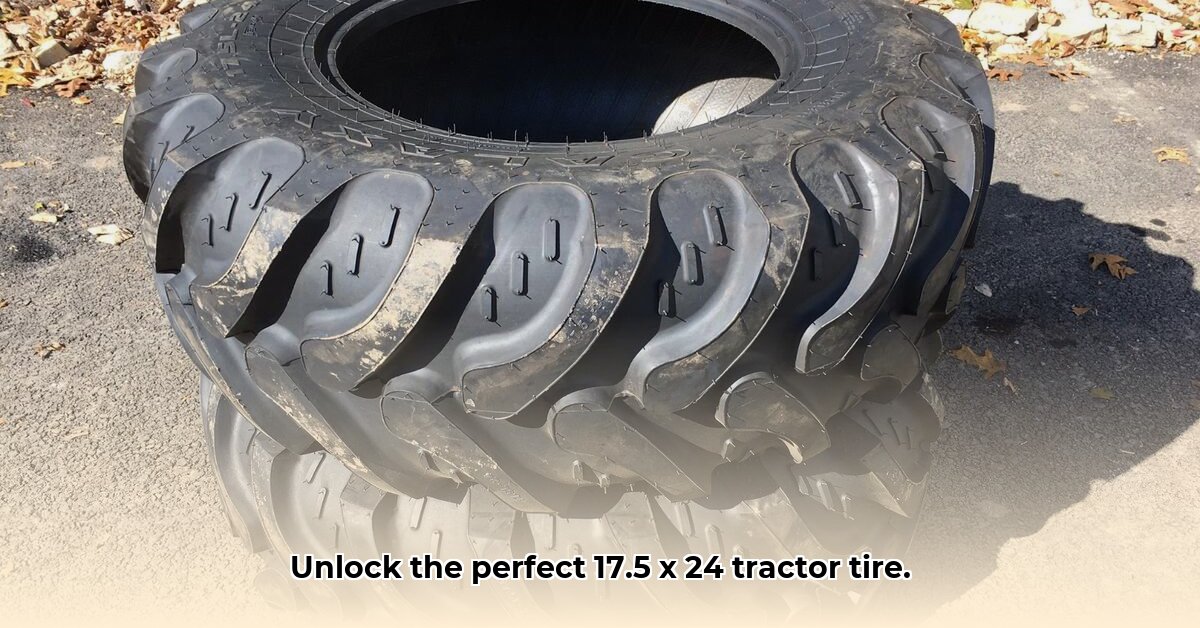
Choosing the right 17.5 x 24 tractor tire is crucial for maximizing efficiency and minimizing downtime. This comprehensive guide will help you navigate the complexities of tire selection, ensuring you make an informed decision that benefits your farm's bottom line. We'll cover everything from ply ratings and tire construction to maintenance and risk mitigation, empowering you to choose the best tire for your specific needs. For more information on other tractor tire sizes, check out this helpful resource: tractor tire guide.
Understanding 17.5 x 24 Tractor Tires: Key Specifications
Before diving into the specifics, let's clarify some important terminology. The "17.5" refers to the tire's width in inches, and "24" represents the tire's diameter. Understanding these dimensions is fundamental in ensuring a proper fit for your tractor. The size is critical for ground clearance and wheel speed.
Ply Rating: Strength and Load Capacity
The ply rating (typically 8, 10, or 12) signifies the tire's structural strength and load-carrying capacity. Higher ply ratings indicate increased strength and durability, suitable for heavier tractors and demanding applications.
- 8-Ply: Suitable for lighter tractors and less demanding tasks. Offers a good balance of cost and performance.
- 10-Ply: A versatile option, providing a balance between strength, durability, and cost. Ideal for moderate workloads.
- 12-Ply: Designed for heavy-duty applications, offering superior load capacity and resistance to damage. Best for heavy tractors and tough terrains.
Choosing the correct ply rating is crucial for safety and optimal performance. Consult your tractor's manual for the recommended ply rating. Incorrectly selecting a tire with too low a ply rating can lead to tire failure and damage to your equipment.
R-4 Tire Construction: Traction and Performance
Most 17.5 x 24 tractor tires utilize R-4 construction. This design features a robust tread pattern optimized for traction, particularly on soft and uneven terrain. The deep lugs provide exceptional grip, minimizing slippage and maximizing efficiency. This makes R-4 tires particularly suitable for agricultural applications.
Top 17.5 x 24 Tractor Tire Brands Compared
Direct comparison of tire performance is challenging due to a lack of standardized testing across brands. The following table provides a general comparison based on available information. Remember: Price ranges and estimated tread life can vary significantly depending on retailer and conditions. Always consult manufacturer specifications for precise details.
| Brand | Price Range (USD) | Estimated Tread Life (Years) | Key Features |
|---|---|---|---|
| Brand A | $500 - $700 | 3-5 | Excellent traction, known for longevity |
| Brand B | $600 - $800 | 2.5-4 | Durable construction, good value for the money |
| Brand C | $400 - $600 | 2-3 | Budget-friendly, suitable for lighter applications |
Note: These estimates are based on industry observation and are not standardized test results. Actual performance can vary.
Performance Metrics: Treadwear and Traction
Two key performance indicators are treadwear and traction.
- Treadwear: Represents the tire's lifespan. Factors influencing treadwear include terrain, workload, and tire maintenance.
- Traction: Measures the tire's ability to grip the ground, influencing fuel efficiency and productivity.
While manufacturers provide specifications, real-world performance depends on usage and maintenance. Regular inspections and proper inflation are critical for maximizing both treadwear and traction. For example, consistently under-inflated tires will lead to significant loss of traction and shorter tread life.
A Step-by-Step Guide to Selecting Your 17.5 x 24 Tractor Tire
Selecting the right tire involves careful consideration of various factors. Follow these steps for a successful and informed purchase:
- Determine your budget: Establish a realistic budget to narrow down your options.
- Assess your workload: Heavy-duty tasks require more robust tires than lighter applications.
- Check your tractor's specifications: Ensure the tire’s load capacity aligns with your tractor's specifications. This is critical for safety reasons.
- Analyze your terrain: The type of terrain (rocky, sandy, muddy) will guide your tire choice.
- Compare tire specifications: Consider ply rating, tread pattern, and construction (R-4).
- Consider manufacturer reputation: Review brand reputation and warranty information. What is the typical lifetime expectancy of their tires?
- Calculate long-term costs: Factor in replacement cost and potential fuel efficiency gains.
Tire Maintenance: Extending Tire Lifespan and Performance
Regular maintenance significantly extends tire life and optimizes performance.
- Maintain correct tire pressure: Consistent inflation prevents uneven wear and maximizes traction. Use a pressure gauge frequently, ideally once a week.
- Regularly inspect tires: Check for cuts, punctures, bulges, and embedded objects.
- Rotate tires: Rotate tires periodically to distribute wear evenly across all tires.
- Proper storage: Store tires away from direct sunlight and extreme temperatures during the off-season.
Risk Mitigation Strategies: Addressing Potential Issues
Addressing potential risks is vital for ensuring safe and efficient operation.
- Tire Failure: Select the appropriate ply rating for your tractor's load capacity. Conduct regular tire inspections. Maintain correct inflation.
- Premature Wear: Follow the recommended maintenance schedule. Rotate tires. Avoid overloading your tractor.
- Supply Chain Disruptions: Order tires in advance, especially during peak seasons.
By following this guide and addressing the outlined risk mitigation strategies, you can make a well-informed decision, maximizing your tractor's performance and minimizing potential issues. Remember, choosing the right tire is an investment in the longevity and productivity of your operation.